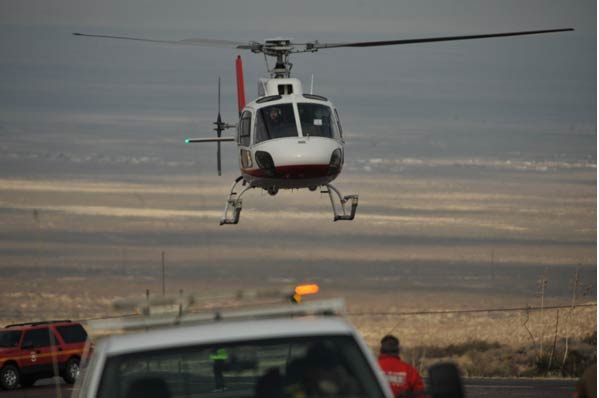The wind chill was close to zero degrees Fahrenheit, caused by a combination of 20-degree weather and strong winds blowing at about 30 miles per hour, with black ice covering the road like a frozen lake,” said Firefighter Paramedic Cosmo Padilla of the NASA White Sands Test Facility (WSTF) Fire and Emergency Services, as he described a recent emergency run response. “Just to access the injured persons involved, all of the responders took great care and effort to reach the victims.”
These were the weather conditions on an early Sunday morning in February when a WSTF Fire and Emergency Services crew responded to a mutual aid call for a multi-vehicle accident in the San Augustin Pass (elevation 7,030 ft.) near the WSTF site. The WSTF Fire and Emergency Services crew arrived at 7:48 a.m. under an advisory of dangerous road conditions with ice and reports of other accidents occurring in the area.
Upon arrival at the scene, the crew found that the icy conditions had caused a crash involving two semi-tractor trailers that had jackknifed and an SUV that had unfortunately collided with the trucks and was trapped in the wreckage. While the passenger was able to exit the SUV, the driver was pinned and needed to be extricated from the vehicle.
“We worked from inside the SUV to stabilize the driver, keep warm, and medicate for extrication and transportation. The front end of the SUV was crashed and wedged under the semi-tractor trailer, and the driver’s legs were trapped under the dash. After 45 minutes of using all of our extrication tools, we finally had to use a wrecker to pull the SUV away from the truck.”

Once out of the wreckage, the injured driver was lifted from the area in a medical evacuation helicopter rather than in an ambulance, because of the black ice and extended extrication time.
“While we were working on the extraction,” continued Padilla, “there were other accidents in the same location because of the black ice. Our Lt. Andy Embury became the Incident Commander and assigned other responders to the subsequent accidents. It was a very tough morning for the accident victims and responders alike.”
And like other responses from the WSTF Fire and Emergency Services, the story did not end there. Passengers needed transportation; New Mexico Department of Transportation (NMDOT) was notified to sand the road; and when the vehicles were removed and the roadway was determined safe, only then did the New Mexico State Police authorize reopening the Pass.
“It’s a coordinated effort each time,” said WSTF Fire Chief Thomas Jones, “when one responder in the area doesn’t have the equipment and others do, then we help each other out. We work together as a community to save lives.”
The WSTF team is proud that our emergency services, while necessary to facilitate the remote hazardous testing that is done at the site, are also able to assist in the community.
NASA Johnson Space Center White Sands Test Facility is a unique, self-contained, and remote testing facility, located in the San Andres Mountains near Las Cruces, NM.

























